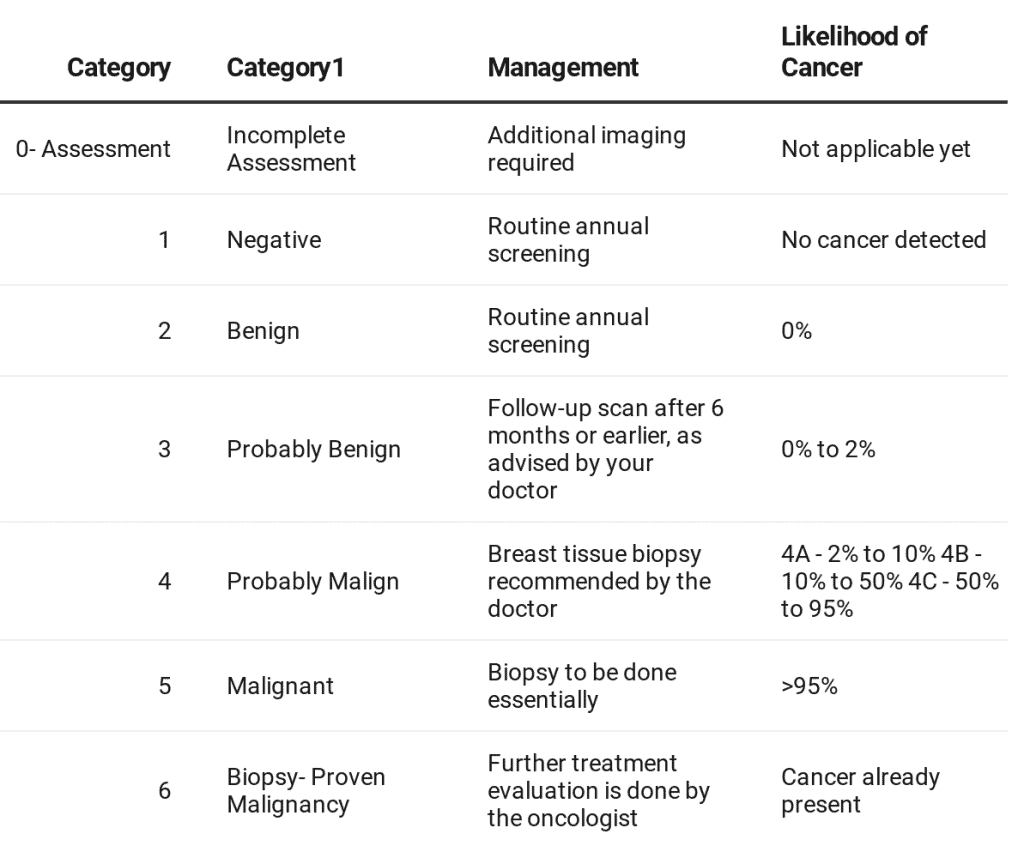
BI-RADS refers to Breast Imaging Reporting and Data System. It is a standardized system developed by the American College of Radiology (ACR) for radiologists to categorize their findings of the mammogram. A mammogram is an X-Ray of the breast and is used to detect early signs of breast cancer.
The BI-RADS score helps radiologists communicate the results of the mammogram clearly to your doctor, along with assessment and follow-up recommendations.
Table of Contents
When your radiologist interprets a mammogram, he/she assigns a numerical value from 0 through 6 to BI-RADS. This score further enables your doctor to assess your breast cancer risk.
Some people wrongly assume this score to be the breast cancer stage. Since this confusion brings unnecessary worry, patients need to be aware of the BI-RADS system of assessment.
Let’s learn about what each BI-RADS value on your mammography or ultrasound report means.
This category is indicative of insufficient imaging information, which means the study is not yet complete. It usually happens when your radiologist finds difficulty in reading the images that may be cloudy or not distinct. It may be due to dense breasts or a technical issue.
In such a case, follow-up imaging is necessary for proper evaluation. The extra imaging is also compared with the previous mammography to check stability.
If you have a BI-RADS 0 score, it is important to get additional imaging done through mammography views, ultrasound or MRI.
When there is no noticeable abnormality in the scan obtained, it is assigned a BI-RADS score of 1. It is a negative report implying that the report is normal and there is no evidence of a lesion or mass.
This report is good news for you as there is no obvious sign of cancer in the mammogram at present. In this case, you can continue with your routine annual screening of the breasts.
The mammography scan in BI-RADS 2 category suggests a benign, i.e. non-cancerous mass. It may include a cyst, calcification or fibroadenomas. These lumps have a 0% risk of turning malignant, i.e. cancerous and do not need a biopsy of the breast tissue for further evaluation.
In this case, too, the doctor usually suggests a routine breast examination.
When the imaging report suggests lesions or masses that probably appear benign, it is put in the category of BI-RADS 3. In comparison to BI-RADS 2, these lumps have a chance of 0 to 2 per cent of turning malignant. These include non-palpable, incidental and complicated cysts.
A 6-month follow-up scan is usually suggested in this category, and there is no need for a biopsy. However, your physician may ask you to follow up earlier than 6 months if you have a family history of breast cancer.
The lumps or lesions found in this category have a greater chance of turning cancerous than the scan in BI-RADS 3. Depending on your case, your doctor may perform a biopsy of the breast tissue to establish a proper diagnosis. BI-RADS 4 is further sub-divided into:
In the BI-RADS 5 category, the scan suggests a lump that has more than 95% risk of turning cancerous. Since the risk of breast cancer is the highest in BI-RADS 5, your doctor will conduct a biopsy to further check your case.
As a side note, certain benign breast conditions like mastitis can also appear cancer-like in the mammogram report. Thus, do not immediately panic and let your doctor provide the correct understanding of the score.
A BI-RADS score of 6 suggests a mammogram of someone who has a known biopsy-proven malignancy. The doctor may recommend the scan for further treatment evaluation or to check the breast cancer stage.

Breast density affects the mammogram report and thus, also the imaging assessment. Dense breasts have less fatty tissue and are twice as likely to develop breast cancer. They also make it difficult for mammograms to detect cancer. BI-RADS and Breast Density
Naturally, a breast cancer diagnosis is hard to accept. However, it is also important to note that early detection is the key to managing breast cancer effectively. For this, you must undergo regular screenings and pay attention to the warning signs.
Your BI-RADS score on the mammography report, indeed, is an important tool for your doctor to assess your breast cancer and suggest further follow-up action. But remember, all breast lumps aren’t cancerous.
So whatever your BI-RADS score, make sure to consult your doctor to rightfully diagnose your condition. Your doctor may additionally ask you to take some tests before any final assessment.
Also, read: Worried about an underarm lump? Find out what it means